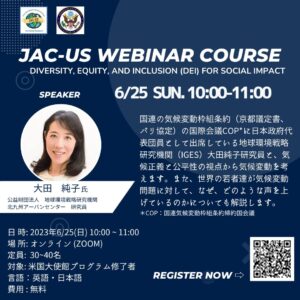[Webinar Report] 5/28 JAC-US WEBINAR COURSE #4

“Public assistance 1, Mutual support 2, Self-help 7."
This is a figure that indicates the ratio of actual evacuation and rescue in the event of a disaster.
This time, JAC-US webinar on disaster prevention was given by Mr. Tatsuya Kato of the Kanagawa Prefectural Government's Department of Life Safety and Disaster Prevention and Mr. Seiji Nakagawa of 3.11 Memorial, a JAC-US core member who has been working to pass on the disaster prevention traditions in Ishinomaki City, Miyagi Prefecture.
Mr. Kato spoke about how to prepare for possible future disasters, based on the actual damage caused by the Great Kanto Earthquake 100 years ago. The ratio above provides hints, such as "Rearrange or fix furniture in the bedroom" and "Use the second floor instead of the first floor as a bedroom," which made us realize that raising individual awareness of disaster prevention is the key to minimizing damage in the event of a disaster.
Mr. Nakagawa conveyed the importance of mutual aid through realistic stories, such as how the people of Ishinomaki city acted when the Great East Japan Earthquake struck, how the teachers and students of Kadonowaki Elementary School evacuated to higher ground, and how they escaped, thanks to the "evacuation cascade" from one person to another. In fact, 77% of the rescued people were rescued with the help of neighbors in Ishinomaki city, and the debris removal was completed in a short period of time thanks to the quick support of NPOs and volunteers.
Both speakers are IVLP alumni. They also talked about the differences in disaster response between Japan and the U.S. based on their experiences in the U.S.
It is said that "whoever controls the information controls the disaster," so gathering information during a disaster is very important. In the U.S., all information is shared in the cloud, whereas at the disaster headquarters in Japan, information is shared on a whiteboard within a few meters... In the U.S., there is the Incident Command System, which defines 18 uniform rules for information gathering and support. In Japan, however, each municipality has its own framework, and the response is uneven, resulting in a lack of prompt and appropriate disaster response.
Disaster prevention is an important and familiar issue for all Japanese people. The participants had a variety of opinions and questions, and the webinar was so rich in content that one hour was far too short. Thank you very much, Mr. Kato and Mr. Nakagawa, for your valuable presentation.
Next month will be the final session, and the theme will be "Environment”. Please stay tuned on our JAC-US webinar series!


